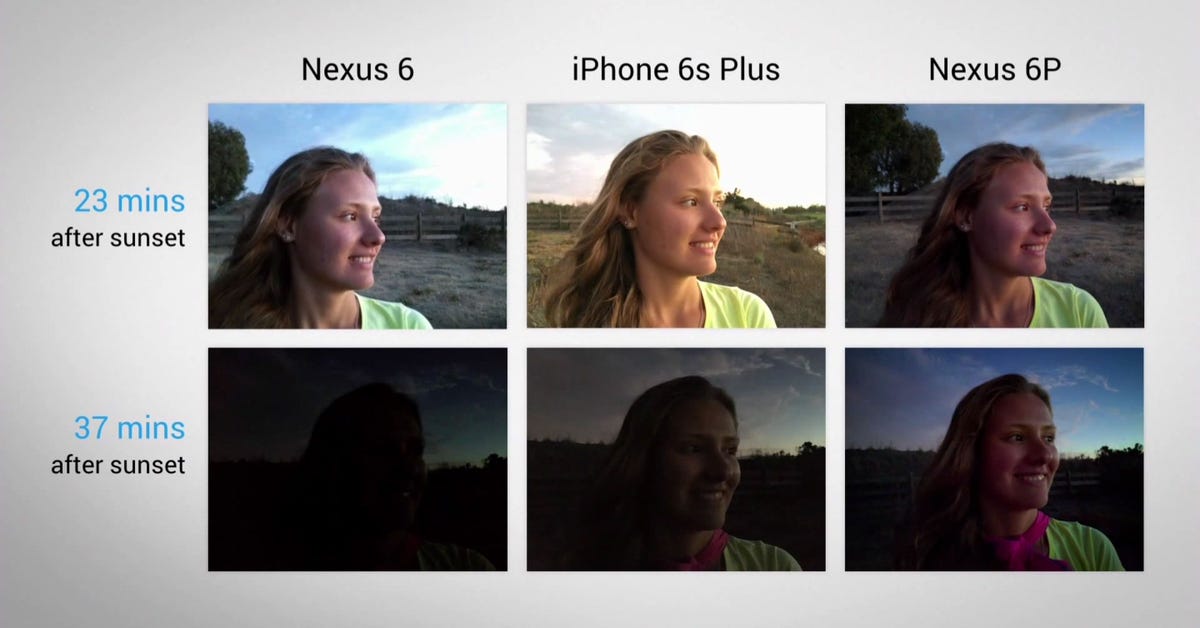 Enlarge Image
Enlarge ImageFor years, Google’s Nexus-branded gadgets have appealed chiefly to a limited audience of techies, but powerful cameras in the upcoming Nexus 5X and 6P smartphones could change that.
Ever since the Nexus One arrived in 2010 , Google has used the line to showcase the abilities of the latest version of its Android mobile software. But each model along the way was hobbled by a mediocre camera. Meanwhile, Apple’s iPhones delivered consistently delivered top-notch photos, and other Android phone sellers including Samsung and LG Electronics put a high priority on cameras.
When Google unveiled the 5.2-inch LG-built Nexus 5X and 5.7-inch Huawei-built Nexus 6P on Tuesday, the first feature it described in depth was the camera. The devices, due in October, have 12.3-megapixel resolution, an image sensor with large pixels that capture light better in low-light indoor and nighttime conditions, slow-motion and high-resolution video abilities, and a laser-based autofocus system.
Smartphone cameras have become a critical consideration as more people document moments in their lives and share photos online immediately with friends and family. (Consider that 400 million people a month use Instagram, Facebook’s photo-sharing network.) A competitive camera means Google can credibly claim that its Nexus phones really do set an example of Android done right, and this could elevate Nexus into a brand name that mainstream consumers actually want.


Now playing:
Watch this:
Google Nexus 6P brings size and speed
2:25
“It’s an amazing camera,” said Dave Burke, Google’s vice president of engineering for Android. He was bold enough to assert that the camera performs better than the one in Apple’s brand-new iPhone 6S.
Some have already taken notice. UK phone retailer Mobiles.co.uk will push the phones to average consumers. “Both LG and Huawei have created two Nexus devices at attractive prices that stand the best chance yet of any Nexus device to cross over to mainstream users,” said spokeswoman Abby Francis.
Google said it’s aiming the Nexus line at tech-savvy customers but sees them as ambassadors to the broader market. “We built Nexus for enthusiasts, and we find increasingly that enthusiasts recommend these phones to their friends and family,” spokeswoman Chelsea Maughan said.
The Mountain View, California, company hasn’t disclosed the number of Nexus smartphones it has sold, but it’s a small fraction of blockbusters like the iPhone or Galaxy S franchises.
High test scores
DxO Labs, an independent French firm that rigorously tests camera performance, gave a preproduction model of the Nexus 6P its second-highest DxOMark mobile score. Of all phones, the Nexus 6P is “by far the best tested to date” when it comes to preserving details in photos taken in dim light, DxO said. The device also has fast and accurate autofocus, renders colors well and does a good job gauging how brightly to expose shots, the company said.

 Enlarge Image
Enlarge ImageGoogle / Screenshot by Stephen Shankland – CNET
The first-place DxOMark smartphone camera belongs to the Samsung Galaxy S6 Edge, but only by a narrow margin: a score of 86 compared with the Nexus 6P’s 84. The DxO hasn’t released results yet for the iPhone 6S or 6S Plus or for the Sony Xperia Z5 , whose camera has a whopping 23-megapixel resolution. The Nexus 5X has the same camera module as the 6P, so it should perform similarly.

 Enlarge Image
Enlarge ImageGoogle / Screenshot by Stephen Shankland / CNET
At the heart of the new Nexus camera is an image sensor built by Sony, which also supplies sensors for the iPhone and top-ranking SLR cameras. Each of the 12.3 million pixels is 1.55 microns wide — a 66th of a human hair’s width. That may sound tiny, but it’s larger than the iPhone 6S Plus’s 1.22-micron pixels and the 1.12-micron pixels in last year’s Nexus 6 phone.
Larger pixels are useful because they can capture more light. That can mean better performance when it’s dark and a better ability to distinguish details both in bright highlights and dim shadows. Behind the scenes, the new Nexus models also take multiple shots and present the one with the least blur.
Achilles heel: no stabilization
The upcoming Nexus phones’ cameras have one big problem, though: no optical image stabilization, a feature that keeps your photos sharp even if your hands move. Done well, stabilization helps in low-light conditions and with videos when the shooter has shaky hands or is walking.
Google’s Burke argued that the image sensor’s large pixels can capture a lot of light, speeding up exposure times so image stabilization isn’t needed. But the DxOMark score heavily dinged the Nexus 6P for video problems.
The Nexus cameras do offer some video improvements. First, they can shoot 4K video, which is far sharper than today’s high-definition 1080p video. The Nexus 5X can also capture HD video at 120 frames per second for video that slows down action by a factor of four, and the Nexus 6P can slow it down by a factor of eight at 240 frames per second. (Here’s one 240fps video of a hummingbird that Burke shared.) Editing software can be used to create a video that shows real-time scenes with a slow-motion segment in the middle to spotlight interesting action.
Real-world testing will eventually show how Google’s latest phones fare against the competition. But the fact that Google is willing to brag about the camera at all shows that Nexus phones have already entered a new era.



